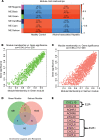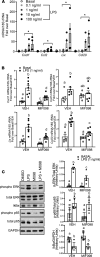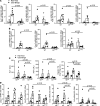Role of MIF in coordinated expression of hepatic chemokines in patients with alcohol-associated hepatitis
- PMID: 33945507
- PMCID: PMC8262327
- DOI: 10.1172/jci.insight.141420
Role of MIF in coordinated expression of hepatic chemokines in patients with alcohol-associated hepatitis
Abstract
The chemokine system of ligands and receptors is implicated in the progression of alcohol-associated hepatitis (AH). Finding upstream regulators could lead to novel therapies. This study involved coordinated expression of chemokines in livers of healthy controls (HC) and patients with AH in 2 distinct cohorts of patients with various chronic liver diseases. Studies in cultured hepatocytes and in tissue-specific KO were used for mechanistic insight into a potential upstream regulator of chemokine expression in AH. Selected C-X-C chemokine members of the IL-8 chemokine family and C-C chemokine CCL20 were highly associated with AH compared with HC but not in patients with liver diseases of other etiologies (nonalcoholic fatty liver disease [NAFLD] and hepatitis C virus [HCV]). Our previous studies implicate macrophage migration inhibitory factor (MIF) as a pleiotropic cytokine/chemokine with the potential to coordinately regulate chemokine expression in AH. LPS-stimulated expression of multiple chemokines in cultured hepatocytes was dependent on MIF. Gao-binge ethanol feeding to mice induced a similar coordinated chemokine expression in livers of WT mice; this was prevented in hepatocyte-specific Mif-KO (MifΔHep) mice. This study demonstrates that patients with AH exhibit a specific, coordinately expressed chemokine signature and that hepatocyte-derived MIF might drive this inflammatory response.
Keywords: Chemokines; Hepatitis; Hepatology; Inflammation; Innate immunity.
Conflict of interest statement
Figures





Similar articles
-
Novel Role of Macrophage Migration Inhibitory Factor in Upstream Control of the Unfolded Protein Response After Ethanol Feeding in Mice.Alcohol Clin Exp Res. 2019 Jul;43(7):1439-1451. doi: 10.1111/acer.14065. Epub 2019 May 14. Alcohol Clin Exp Res. 2019. PMID: 31009094 Free PMC article.
-
Hepatocyte-derived macrophage migration inhibitory factor mediates alcohol-induced liver injury in mice and patients.J Hepatol. 2017 Nov;67(5):1018-1025. doi: 10.1016/j.jhep.2017.06.014. Epub 2017 Jun 22. J Hepatol. 2017. PMID: 28647568 Free PMC article.
-
Macrophage migration inhibitory factor contributes to ethanol-induced liver injury by mediating cell injury, steatohepatitis, and steatosis.Hepatology. 2013 May;57(5):1980-91. doi: 10.1002/hep.26169. Epub 2013 Jan 18. Hepatology. 2013. PMID: 23174952 Free PMC article.
-
Interleukin-22 in alcoholic hepatitis and beyond.Hepatol Int. 2020 Sep;14(5):667-676. doi: 10.1007/s12072-020-10082-6. Epub 2020 Sep 5. Hepatol Int. 2020. PMID: 32892258 Free PMC article. Review.
-
[The diagnostic role of chemokines and their receptors in chronic hepatitis C].Klin Lab Diagn. 2013 Feb;(2):23-9. Klin Lab Diagn. 2013. PMID: 23808006 Review. Russian.
Cited by
-
Alcohol-Related Liver Disease: An Overview on Pathophysiology, Diagnosis and Therapeutic Perspectives.Biomedicines. 2022 Oct 10;10(10):2530. doi: 10.3390/biomedicines10102530. Biomedicines. 2022. PMID: 36289791 Free PMC article. Review.
-
Role of the chemokine system in liver fibrosis: a narrative review.Dig Med Res. 2022 Jun;5:30. doi: 10.21037/dmr-21-87. Epub 2022 Jun 30. Dig Med Res. 2022. PMID: 36339901 Free PMC article.
-
Pathogenesis of Alcohol-Associated Liver Disease.J Clin Exp Hepatol. 2022 Nov-Dec;12(6):1492-1513. doi: 10.1016/j.jceh.2022.05.004. Epub 2022 May 31. J Clin Exp Hepatol. 2022. PMID: 36340300 Free PMC article. Review.
-
Recent Advances in Understanding of Pathogenesis of Alcohol-Associated Liver Disease.Annu Rev Pathol. 2023 Jan 24;18:411-438. doi: 10.1146/annurev-pathmechdis-031521-030435. Epub 2022 Oct 21. Annu Rev Pathol. 2023. PMID: 36270295 Free PMC article. Review.
-
Single-Cell RNA Sequencing Reveals Macrophage Dynamics During MASH in Leptin-Deficient Rats.Cells. 2025 Jan 10;14(2):96. doi: 10.3390/cells14020096. Cells. 2025. PMID: 39851524 Free PMC article.
References
Publication types
MeSH terms
Substances
Grants and funding
LinkOut - more resources
Full Text Sources
Other Literature Sources
Molecular Biology Databases
Research Materials
Miscellaneous

